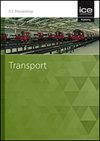根据交叉口实际区域的交通状况进行交叉口优化研究
IF 1.2
4区 工程技术
Q4 ENGINEERING, CIVIL
Proceedings of the Institution of Civil Engineers-Transport
Pub Date : 2024-02-26
DOI:10.1680/jtran.23.00106
引用次数: 0
摘要
随着当代汽车保有量的增加,城市交叉路口在机动化和拥堵方面面临着日益严峻的挑战。传统的信号配时方案往往难以处理交叉口物理区域内由此产生的车辆冲突。因此,本研究提出了一种基于交叉口物理区域交通状况(IPAT-ATS)的交叉口交通信号配时方法。根据各种异常车辆运行状态对各出入口车道车辆流量的影响,定义了不同类型的交叉口异常。利用交通效率模型,分析不同异常状态下交叉口的流量状态,优化交通流量分配,从而最大限度地提高各种异常状态下的交通效率。提出的方法在天津市围堤道和友谊路交叉口进行了模拟测试。与当前的信号配时方案相比,该方法显著提高了不同交通异常情况下的交叉口效率。本文章由计算机程序翻译,如有差异,请以英文原文为准。
Intersection optimization study based on traffic conditions in the physical area of intersections
The contemporary prevalence of car ownership has presented urban intersections with burgeoning challenges in terms of motorization and congestion. Traditional signal timing schemes often encounter difficulties in handling the resulting vehicle conflicts within the physical area of the intersection. Accordingly, an intersection traffic signal timing method based on Intersection Physical Zone Traffic Status (IPAT-ATS) is proposed in this study. Different types of intersection anomalies are defined based on the impact of various abnormal vehicle operating states on vehicle flow in each entrance and exit lane. Using a traffic efficiency model, the flow state of intersections under different abnormal states is analyzed to optimally allocate traffic flows, thereby maximizing traffic efficiency under various abnormal states. The proposed method undergoes testing through simulations at the Weidi Road and Youyi Road intersection in Tianjin. Compared with the current signal timing scheme, this method significantly enhances the intersection efficiency for different traffic anomalies.
求助全文
通过发布文献求助,成功后即可免费获取论文全文。
去求助
来源期刊
CiteScore
2.60
自引率
0.00%
发文量
42
审稿时长
5 months
期刊介绍:
Transport is essential reading for those needing information on civil engineering developments across all areas of transport. This journal covers all aspects of planning, design, construction, maintenance and project management for the movement of goods and people.
Specific topics covered include: transport planning and policy, construction of infrastructure projects, traffic management, airports and highway pavement maintenance and performance and the economic and environmental aspects of urban and inter-urban transportation systems.

 求助内容:
求助内容: 应助结果提醒方式:
应助结果提醒方式:


